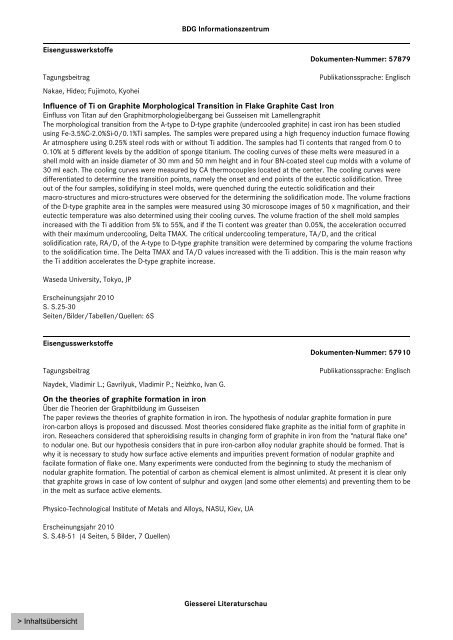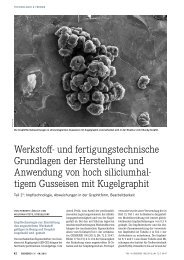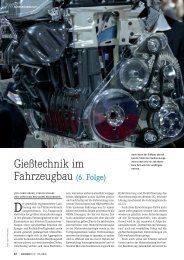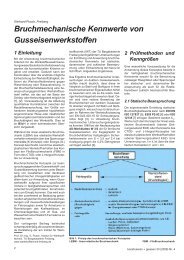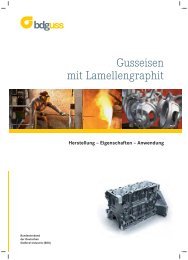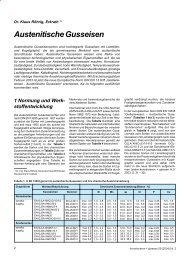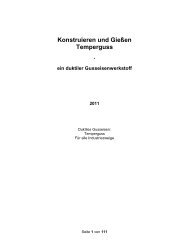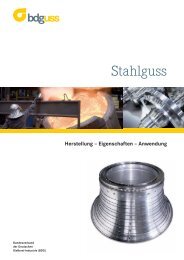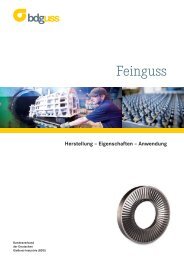Giesserei Literaturschau - Bundesverband der Deutschen Gießerei ...
Giesserei Literaturschau - Bundesverband der Deutschen Gießerei ...
Giesserei Literaturschau - Bundesverband der Deutschen Gießerei ...
Sie wollen auch ein ePaper? Erhöhen Sie die Reichweite Ihrer Titel.
YUMPU macht aus Druck-PDFs automatisch weboptimierte ePaper, die Google liebt.
BDG Informationszentrum<br />
Eisengusswerkstoffe<br />
Dokumenten-Nummer: 57879<br />
Tagungsbeitrag<br />
Nakae, Hideo; Fujimoto, Kyohei<br />
Publikationssprache: Englisch<br />
Influence of Ti on Graphite Morphological Transition in Flake Graphite Cast Iron<br />
Einfluss von Titan auf den Graphitmorphologieübergang bei Gusseisen mit Lamellengraphit<br />
The morphological transition from the A-type to D-type graphite (un<strong>der</strong>cooled graphite) in cast iron has been studied<br />
using Fe-3.5%C-2.0%Si-0/0.1%Ti samples. The samples were prepared using a high frequency induction furnace flowing<br />
Ar atmosphere using 0.25% steel rods with or without Ti addition. The samples had Ti contents that ranged from 0 to<br />
0.10% at 5 different levels by the addition of sponge titanium. The cooling curves of these melts were measured in a<br />
shell mold with an inside diameter of 30 mm and 50 mm height and in four BN-coated steel cup molds with a volume of<br />
30 ml each. The cooling curves were measured by CA thermocouples located at the center. The cooling curves were<br />
differentiated to determine the transition points, namely the onset and end points of the eutectic solidification. Three<br />
out of the four samples, solidifying in steel molds, were quenched during the eutectic solidification and their<br />
macro-structures and micro-structures were observed for the determining the solidification mode. The volume fractions<br />
of the D-type graphite area in the samples were measured using 30 microscope images of 50 x magnification, and their<br />
eutectic temperature was also determined using their cooling curves. The volume fraction of the shell mold samples<br />
increased with the Ti addition from 5% to 55%, and if the Ti content was greater than 0.05%, the acceleration occurred<br />
with their maximum un<strong>der</strong>cooling, Delta TMAX. The critical un<strong>der</strong>cooling temperature, TA/D, and the critical<br />
solidification rate, RA/D, of the A-type to D-type graphite transition were determined by comparing the volume fractions<br />
to the solidification time. The Delta TMAX and TA/D values increased with the Ti addition. This is the main reason why<br />
the Ti addition accelerates the D-type graphite increase.<br />
Waseda University, Tokyo, JP<br />
Erscheinungsjahr 2010<br />
S. S.25-30<br />
Seiten/Bil<strong>der</strong>/Tabellen/Quellen: 6S<br />
Eisengusswerkstoffe<br />
Dokumenten-Nummer: 57910<br />
Tagungsbeitrag<br />
Naydek, Vladimir L.; Gavrilyuk, Vladimir P.; Neizhko, Ivan G.<br />
Publikationssprache: Englisch<br />
On the theories of graphite formation in iron<br />
Über die Theorien <strong>der</strong> Graphitbildung im Gusseisen<br />
The paper reviews the theories of graphite formation in iron. The hypothesis of nodular graphite formation in pure<br />
iron-carbon alloys is proposed and discussed. Most theories consi<strong>der</strong>ed flake graphite as the initial form of graphite in<br />
iron. Reseachers consi<strong>der</strong>ed that spheroidising results in changing form of graphite in iron from the "natural flake one"<br />
to nodular one. But our hypothesis consi<strong>der</strong>s that in pure iron-carbon alloy nodular graphite should be formed. That is<br />
why it is necessary to study how surface active elements and impurities prevent formation of nodular graphite and<br />
facilate formation of flake one. Many experiments were conducted from the beginning to study the mechanism of<br />
nodular graphite formation. The potential of carbon as chemical element is almost unlimited. At present it is clear only<br />
that graphite grows in case of low content of sulphur and oxygen (and some other elements) and preventing them to be<br />
in the melt as surface active elements.<br />
Physico-Technological Institute of Metals and Alloys, NASU, Kiev, UA<br />
Erscheinungsjahr 2010<br />
S. S.48-51 (4 Seiten, 5 Bil<strong>der</strong>, 7 Quellen)<br />
<strong>Giesserei</strong> <strong>Literaturschau</strong>


